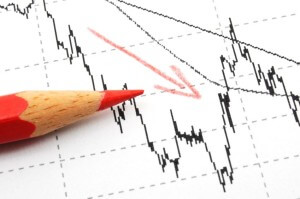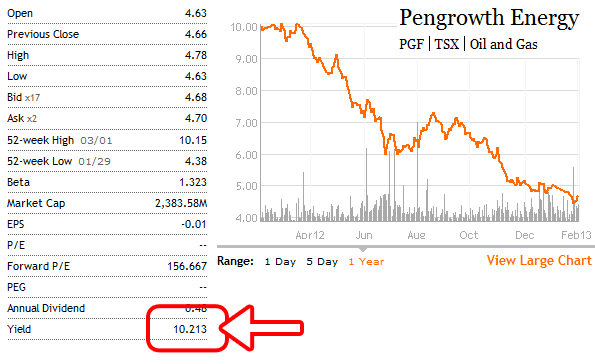This article was published in the February 2013 edition of the Canadian MoneySaver, and is posted here with permission. For more information visit www.canadianmoneysaver.ca

Image credit: gunnar3000 / 123RF Stock Photo
Most investors would never buy a corporate bond yielding 10%. They would understand that a high yield in this low-interest rate environment would be a risky investment. They would likely lose some or all of their investment. But many investors who do not understand the risks of high yield, will buy dividend stocks paying 8% or 10%+ yields, double or triple what blue chips are currently paying at 3% to 4.5%. While high-yield stocks are not junk bonds, they do inherently carry much more risk than their blue-chip counterparts. Many investors simply focus on yield, not understanding the risks involved with these types of stocks. In this two-part series, I hope to illustrate some of these risks.
What is a High Yield Stock?
Wikipedia defines a high-yield stock as “a stock whose dividend yield is higher than the yield of any benchmark average. “ That’s a pretty relative measure, since many blue chip stocks have a higher yield when compared to their peers. But most investors would agree anything over a 10% dividend yield is a high yield stock. It’s the nebulous area between 5% and 10% dividend yields where investors also need to be more cautious.
I define a high-yield stock as any stock whose yield is double or higher the average in its sector. For example, Pengrowth Energy (PGF) has a current yield of 9.5%. In comparison, the current yield of the BMO TSX Equal Weight Oil & Gas ETF (ZEO) is 3.92%. As another example, AGF Management (AGF) has a current whopping dividend yield of 11.74%. In comparison, iShares S&P/TSX Financials Capped Index Fund (XFN) has a current distribution yield of 3.5%. Therefore, I consider both AGF and PGF as high-yield stocks.
As a general rule of thumb, The Ninja says:
A large-cap should never pay more than a 5% dividend yield.
A small-cap should never pay more than a 7% dividend yield.
A company with a 10%+ yield is a speculative investment.
The Lure of High Yield
The point of dividend investing is to invest in stable and profitable companies that pay a portion of their profits to shareholders. Those profits are distributed as dividends. A profitable and stable company will pay out a reasonable dividend yield and also increase that payout over time. Companies like McDonald’s (MCD) and Coca-Cola (KO) do not need to offer a high dividend yield to attract investors. Their branding and global recognition, economic moats, combined with stable earnings are their selling points.
A smaller-cap company may initially offer a higher yield to attract investors. Otherwise, no investor would want to invest in the company in the first place. Therefore, higher-yield stocks are inherently more risky from the onset. However, the higher yield is usually the result of other factors, such as a declining share price.
When you buy a company with a high dividend yield, you are taking on more risk in return for the higher yield. That’s the trade-off. If you are being paid a high yield to own a company then you will likely see less growth, more volatility in the share price, and take on all the inherent risks of owning that company. Those risks can include low profit margins, negative earnings, as well as high debt. Since they may also pay out a large portion of their earnings out to shareholders, there is little room left for dividend growth or an increase in share price. There is usually the looming threat of a dividend cut.
As mentioned previously, high-yield stocks are far more volatile, and their share price can turn dramatically on missed earnings or sudden economic shifts. We’ve seen that recently with junior oil and gas companies. As companies with high dividend yields are more vulnerable to economic shifts, they can often be hit before broad market sell-offs. This can have a big impact on your portfolio returns, when their share price suddenly plunges. Unless you understand the company and the company industry in-depth, then high-yield stocks are likely to get you in trouble more times than not. There is simply no free lunch with a high-yield stock.
Before You Back Up the Truck
Before you back up the truck on a high-yield stock that appears to be cheap or on sale, here are some red flags and questions you may want to consider:
A Crashing Share Price
Is the stock simply cheap because of a crashing share price? The price and yield of a dividend stock are inversely correlated. Therefore, as a stock price declines, the dividend yield will increase.
Dividend Yield = annual dividend per share / stock’s price per share
A declining share price is more often than not the reason for the high dividend yield (see Figure. 1 below for Pengrowth Energy). A crashing share price is also a warning sign of significant underlying issues. These can include declining sales and earnings, narrowing margins, increasing debt, or diminishing profits. It can also be a warning sign of systemic management issues and problems.

Figure 1. Pengrowth Energy declining share price with increasing yield (Feb. 4th, 2013).
High-yield stocks are seldom on sale because a low share price is the market’s reflection of these issues. More often than not, it’s better to sell a stock whose share price is crashing than hold on and hope for a rebound. Furthermore, a company with a declining share price and high yield will at some point need to cut its dividend. It may also continue to cut or even suspend its dividend, since it may have no other options.
High Dividend Payout Ratios
One measure to determine a sustainable dividend yield is to look at the DPR (Dividend Payout Ratio). I covered the importance of the Dividend Payout Ratio back in the July-August 2011 issue of Canadian MoneySaver. Dividend investors consider 30% to 60% as the ideal Dividend Payout Ratio. This allows companies to pay a reasonable dividend yield, meet their business obligations, and continue to expand their business and even raise the dividend. If the Dividend Payout Ratio is over 70%, and the company is not a REIT (Real Estate Investment Trust), utility, or oil and gas producer, then you should raise a red flag.
Cash Flow vs. EPS
Does the company measure out its payout ratio on cash flow instead of earnings? If so, do you know what the payout ratio is, and is it in line with its peers? I briefly covered cash flow vs. EPS in the November 2011 issue of Canadian MoneySaver. Most of the previous Income Trusts for example, measure their payout ratios with distributable cash flow instead of earnings (EPS). REITs for example, distribute their dividends with AFFO (Adjusted Funds from Operations).
If the DPR (Dividend Payout Ratio) is 100% or more based on EPS, then the company is likely using cash flow to measure its payout ratio. I generally avoid small-cap companies that base their payout on cash flow because they are more difficult to analyze, and have more inherent risk involved.
Borrowing to Fund the Dividend
Is the company leveraging the dividend? In other words, is the company paying an unusually high dividend and borrowing money at the same time? Borrowing capital is a normal part of business and CAPEX (capital expenditures). Usually borrowing is done by issuing corporate bonds and preferred shares. However, a company which is borrowing at a rapid pace while paying a high yield is a big red flag. This may indicate that the company cannot afford to pay its dividend, so is borrowing to make up the difference.
You can check the company releases on a website such as Yahoo Finance or the Globe and Mail to see if the company is issuing new bonds or shares. Also be sure to check the amount the company is issuing, and compare that amount as a percentage of its market cap. Is it reasonable, or does it seem unusually high?
In Part 2, I will cover more of the risks associated with high-yield stocks…
Readers, what’s your take? Do you own high-yield stocks in your portfolio? Do you have a different take on these high-yield dividend payers?
Mid February 2013 Favorite Blog Posts | Modest Money
[...] The Lure and Dangers of High Yield Stocks (Part-1) on Dividend Ninja [...]
Read more comments...
Copyright © 2013 by The Dividend Ninja. All rights reserved. If you are not reading this post in your RSS Reader then the content has been scraped without the authors permission.

























